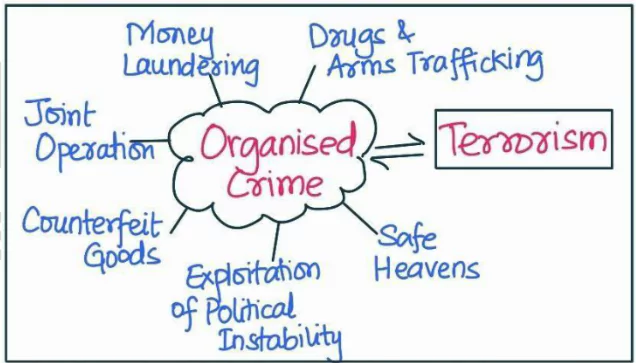Answer:
|
How to approach the question
- Introduction
- Write about Organized crime and terrorism briefly.
- Body
- Write how Organized crime and terrorism have developed a symbiotic relationship at national levels.
- Write how Organized crime and terrorism have developed a symbiotic relationship at transnational levels.
- Write the viable measures to effectively address these complex issues.
- Conclusion
- Give appropriate conclusion in this regard
|
Introduction
Organized crime refers to systematic, illegal activities by highly structured groups for profit. Ex– Sinaloa Cartel etc. Terrorism involves violent acts by individuals or groups to create fear, typically for political purposes. The two often intersect, with organized crime funding terrorism and terrorists employing criminal tactics to further their cause. Ex- Al- Qaeda.
Body
Organized crime and terrorism have developed a symbiotic relationship at national levels as seen in
- Funding: Terrorist groups often rely on organized crime, such as drug trafficking or smuggling, to finance their operations. For example, D-company, a notorious criminal syndicate, allegedly has connections to various terrorist organizations and provides financial assistance to them.
- Weapons Supply: Organized crime syndicates, with their extensive black-market connections, supply weapons to terrorist organizations. In India, insurgent groups in the Northeast have reportedly sourced weapons from organized crime syndicates.
- Money Laundering: Organized crime syndicates offer sophisticated money-laundering services to clean illicit funds for terrorist groups. Example: the Indian Mujahideen’s finances itself by money laundering through various illicit means.
 Intelligence Sharing: Organized crime outfits can provide valuable local intelligence to terrorist groups, helping them plan and execute attacks more effectively. In Mumbai’s 2008 terrorist attack, there were allegations of intelligence sharing between criminals and terrorists.
Intelligence Sharing: Organized crime outfits can provide valuable local intelligence to terrorist groups, helping them plan and execute attacks more effectively. In Mumbai’s 2008 terrorist attack, there were allegations of intelligence sharing between criminals and terrorists.- Safe Havens: In regions where the state has little control, organized crime outfits often provide safe havens for terrorists. For example, in India, certain areas in the states of Jammu and Kashmir have been reported as safe havens for both criminals and terrorists.
- Joint Operations: In some cases, organized crime syndicates and terrorist groups collaborate in joint operations. Example: the Indian Mujahideen and D-company have allegedly collaborated, resulting in incidents like the 2008 Ahmedabad bombings.
Organized crime and terrorism have developed a symbiotic relationship at transnational levels as can be seen in
- Drugs and Arms Trafficking: Organized crime syndicates like Mexico’s Sinaloa Cartel and terrorist groups like Colombia’s FARC have allegedly collaborated on drug and arms trafficking. The revenue from these activities’ funds terrorism, while the syndicates expand their operations.
- Kidnapping and Ransom: Terrorist groups like Al-Qaeda in the Islamic Maghreb (AQIM) often carry out kidnappings for ransom, employing organized crime networks to negotiate and transfer the ransoms, given their established channels.
- Human Trafficking: Organized crime outfits traffic individuals across borders, with some ending up recruited by terrorist groups. For instance, Boko Haram has reportedly used human trafficked individuals from Nigeria in their operations.
- Counterfeit Goods: Organized crime syndicates produce and distribute counterfeit goods on a global scale, contributing to the funding of terrorist groups. Reports have linked the sale of counterfeit goods in Europe to the funding of groups like Hezbollah.
- Exploitation of Political Instability: Both can exploit regions of political instability to strengthen their foothold and operations. In Afghanistan, the Taliban and organized crime have allegedly intertwined, exploiting the nation’s opium trade.
- Illegal Oil Trade: Organized crime syndicates facilitate the illicit trade of oil, which can provide significant funding to terrorist groups. ISIS notably funded its operations through illegal oil sales, often utilizing organized crime groups for distribution.
Viable measures to effectively address these complex issues includes
- Strengthening Legal Framework: Implementing and enforcing robust laws against both organized crime and terrorism is essential. The Unlawful Activities (Prevention) Act (UAPA) in India can be further strengthened to tackle the fusion of these threats.
- International Cooperation: India’s collaboration with agencies like Interpol, and bilateral agreements with nations like Bangladesh and Nepal to curb cross-border crime and terrorism, serve as good examples.
- Capacity Building: Law enforcement agencies need to be trained and equipped to deal with the ever-evolving strategies of organized crime syndicates and terrorist groups. CBI and NIA can frequently conduct such training.
- Community Engagement: Working with communities to prevent radicalization and to encourage the reporting of suspicious activities is crucial. Promoting Indian programs like “Operation Sadbhavana” in J&K aim to win the hearts and minds of locals.
- Targeting Underlying Social Issues: Such as poverty, unemployment, and lack of education that create a conducive environment for organized crime and terrorism. India’s various social programs like “Skill India” and “Sarva Shiksha Abhiyan” play a role here.
- Financial Measures: Measures to cut off the funding to these groups, including stricter banking regulations and improved tracking of money laundering, are vital. India’s Financial Intelligence Unit (FIU-IND) can play a significant role in this regard.
Conclusion
Overall, the intersection of organized crime and terrorism requires an integrated, holistic strategy with proper law enforcement and intelligence measures coupled with broader socio-economic interventions to address the root causes of these threats. India, like many countries, needs to continuously refine its strategies to counter these complex issues.
To get PDF version, Please click on "Print PDF" button.
 Intelligence Sharing: Organized crime outfits can provide valuable local intelligence to terrorist groups, helping them plan and execute attacks more effectively. In Mumbai’s 2008 terrorist attack, there were allegations of intelligence sharing between criminals and terrorists.
Intelligence Sharing: Organized crime outfits can provide valuable local intelligence to terrorist groups, helping them plan and execute attacks more effectively. In Mumbai’s 2008 terrorist attack, there were allegations of intelligence sharing between criminals and terrorists.
Latest Comments